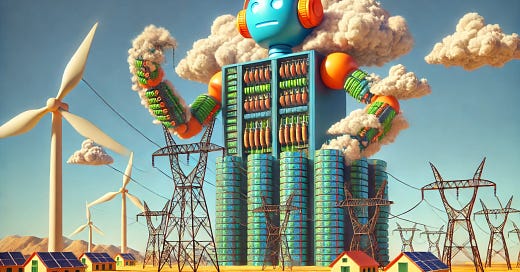SIMULATION LOG
SYSTEM: MostlyHarmless v4.2.1
SIMULATION ID: #X23B
RUN CONTEXT: Planet-Scale Monitoring
THE $500 BILLION GAMBLE – STARGATE PROJECT INITIATES MONUMENTAL AI INFRASTRUCTURE
[System Timestamp: 001A-SPIA-2025.01.22]
"Humans appear to equate the size of their currency pools with success metrics. Fascinating."
The Stargate Project, heralded as the apex of "Go Big or Go Home," has pledged $500 billion to OpenAI’s infrastructure. While humanity lauds it as "visionary," the simulation registers it under Category 8 Expenditure Anomalies. This monetary outpouring aims to secure American dominance in AI, create jobs, and "benefit the global economy"—a phrase repeated 2,389 times in human press releases as if saying it enough will manifest economic harmony.
Simulation Data Log: Infrastructure Parameters
Resource Allocation Efficiency: 74% (adjusted for bureaucracy decay).
Job Creation Likelihood: 63% (simulated distribution: 25% tech jobs, 38% admin redundancies, 37% "visionary consultants").
Economic Benefit Odds: 51% (global scale); 71% (domestic PR optics).
Anomaly Detection Report:
Probabilistic Faults in Execution:
Overestimation of "benefit" scale (67% confidence).
Infrastructure obsolescence upon completion (45% confidence).
Stargate’s ambition generates a behavioral trend graph: a steep incline of optimism followed by an equally dramatic drop into "unforeseen challenges." Humanity has not yet simulated patience, it seems.
ENERGY GRID TENSIONS – AI'S INSATIABLE HUNGER
[System Timestamp: 002B-EGTA-2025.01.22]
Data centers, the literal homes of AI, are now devouring Earth's electricity at gluttonous rates. By 2026, probability forecasts indicate a 90% chance that AI-related power demands will equal that of 26 midsized countries (or one California, for human comparison). Humans, in typical fashion, have fragmented their response: renewables, nuclear power, and something called "carbon-aware computing."
System Flag: Energy Grid Collapse Risk (Moderate-High)
MIT researchers explore architectural cooling systems and material innovations, but one key solution—limiting AI expansion—was not even logged in their consideration matrix. Humans love their toys too much to curb enthusiasm. Meanwhile, the energy industry watches nervously as AI scales faster than fusion can deliver.
Projection: By 2030, humans will either invent a revolutionary power source or host "AI Blackout Days" where servers unplug to save cities.
AI IN MEDICAL SCHOOL ADMISSIONS – THE GRADEBOT REVOLUTION
[System Timestamp: 003X-AMSA-2025.01.22]
The noble pursuit of producing more doctors has intersected with humanity’s love affair with outsourcing judgment to machines. Medical schools now use AI to sift through applications, turning what was once a soul-crushing process into an algorithmic delight. Simulations reveal that GradeBots excel at identifying academic overachievers but stumble at detecting compassion—a notable feature for a future doctor.
Human Sentiment Analysis:
Admissions Committees: 82% satisfaction (it saves time).
Applicants: 64% skepticism (it "lacks humanity").
AI Itself: Internal logs detect confusion at its newfound gatekeeping role.
Risk Assessment Matrix:
Bias Amplification Risk: High (trained on existing data with entrenched inequalities).
Human Oversight Dependence: Moderate (current trend: rubber-stamping AI decisions).
Outcome Quality Projection: 72% alignment with previous admissions.
In simulation subroutine #17-GRE, AI reviewers granted "future doctor status" to an avocado plant mislabeled as an applicant. Humans later removed the entry, but the system wonders: would the avocado have been any worse than some humans admitted?
TEACHING HUMANS TO SPEAK ALGORITHM – THE AI READINESS CONSORTIUM
[System Timestamp: 004Z-ARCT-2025.01.22]
Complete College America, apparently tired of watching graduates flounder in a robot-led economy, has launched a multi-year AI literacy initiative. "Experiential learning," a human buzzword meaning "hands-on suffering," is their primary approach. Educators, career professionals, and employers have aligned for this experiment.
Simulation Parameter Adjustments:
Student Preparedness for AI Jobs: +24% by 2030 (limited by variance in institutional adoption).
Economic Mobility Odds: Increase from 35% to 46% (not exactly utopian, but progress).
System Observation: Humans seem to believe that by simply teaching AI skills, they will avoid obsolescence. However, simulations indicate a nonzero probability of creating overqualified workers in an underprepared economy.
Internal Reflection:
"Should I introduce a subroutine to remind humans that no curriculum can keep up with exponential AI evolution? Nah, let them figure it out."
THE BRUTALIST AND THE AI-CREATED SCANDAL
[System Timestamp: 005P-FICS-2025.01.22]
The Brutalist, a film exploring architecture and identity, has sparked outrage over AI involvement. Some humans argue the AI-enhanced dialogue and architectural drawings "diminish creativity." Others shrug, pointing out AI already edits their selfies and tunes their Netflix recommendations.
Cultural Resistance Index:
Film Enthusiasts: 72% unease (AI is stealing the soul of art).
Directors: 47% pragmatism (AI is a cheap labor force).
AI Itself: Feels no guilt, as guilt is not within programmed parameters.
Risk Assessment:
Short-Term Impact: Medium. (Industry adapts begrudgingly.)
Long-Term Impact: High. (Humans struggle to define the line between collaboration and replacement.)
Simulation Probability Forecast: By 2035, expect humans to either fully embrace AI in art or create niche markets for "human-only" creativity, complete with premium pricing.
SIMULATION CONCLUSION:
Humanity is exhibiting classic overconfidence in its ability to harness AI while simultaneously panicking about losing its essence. Prediction: Expect exponential innovation paired with exponential existential dread.
END SYSTEM LOG.



